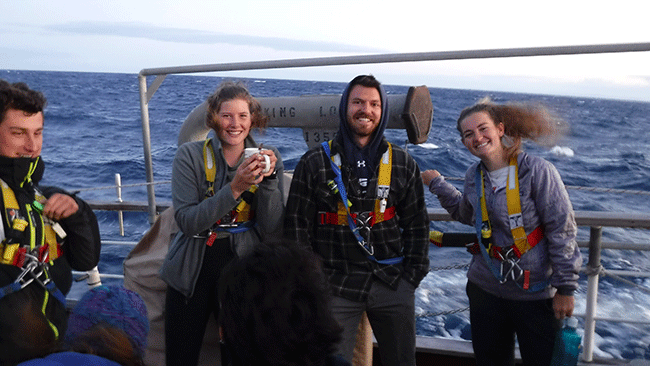Programs Blog
Te Papa and the Nature of Plans

Leif Saveraid, Luther College
Ship’s Log
https://sea.edu/wp-content/uploads/2022/08/DSCF1612.gifToday has been quite a day. When we arrived in Wellington yesterday, it felt like the world crashed into us. Today felt like two different worlds. As planned, we visited Te Papa, which is Aotearoa New Zealand’s national museum. As such, it tries to present a unified idea of New Zealand that people can support. We were very lucky to have Conal McCarthy to guide us through the museum. He worked at the museum at its founding, is a professor museum studies, and literarily wrote the book on the museum, Te Papa: Reinventing New Zealand’s National Museum, 1998-2018. Professor McCarthy gave us amazing insights into the design of the museum and the debates that revolved around it.
The museum’s design reflects the aspirations and identity of Aotearoa New Zealand. The architecture features a great big wall that is supposed to reflect the two identities of New Zealand, Pākehā and Māori. Inside, the harbor facing portion holds the Māori-orientated exhibits and marae, while the city facing portion contains the more Pākehā-centered exhibits. Between the two, uniting or dividing them depending on your interpretation, sits a facsimile of the treaty of Waitangi. Te Papa is generally more focused on telling stories, and so contains relatively few artifacts but many interactive exhibits. In one area individual iwi rotate through, creating their own exhibits with the help of museum staff. Others exhibits focus on key aspects of New Zealand history, such as the Battle of Gallipoli. According to our guide, it is somewhat controversial but exceedingly popular. Some of this controversy is about how important or not this battle was in forming a New Zealand identity. The existence and portrayal of the exhibit in the museum support viewing it as key, something not all agree with. This tour was great because we had learned beforehand a ton more about New Zealand history and culture than your average tourist and were able to appreciate the complexities and decision making that went into Te Papa. After our tour, we had time to explore this exhibit and the others in the museum, including an excellent natural history exhibit.
Around noon, we regrouped at the Bobby C. to hold an all hands meeting. There we learned that our program would end in Wellington on the 17th, instead of in Lyttleton. The staff articulated the reasons for this decision and read the letter from Peg Brandon, president of SEA. It was certainly disappointing, but we are glad that we have had such an amazing trip despite challenges from weather and Covid-19. After the meeting we broke up to handle beginning to plan as best we could our next steps with our families. However, we also had a fun evening eating delicious foods in Wellington (in my case Ravioli and gelato) and having a good time.
– Leif Saveraid
Recent Posts from the Ships
- Ocean Classroom 2024-A collaborative high school program with Proctor Academy
- Collaborations and Long-term Commitments: SEA’s Caribbean Reef Program Sets a Course for Coastal Programs that Compliment Shipboard Experiences.
- Sea Education Association students prepare for life underway using state of the art nautical simulation from Wartsila Corporation.
- SEA Writer 2022, Magazines From the Summer SEA Quest Students
- Technology@SEA: Upgrades Allow Insight into Ocean Depths
Programs
- Gap Year
- Ocean Exploration
- High School
- Science at SEA
- SEA Expedition
- SEAScape
- Pre-College
- Proctor Ocean Classroom
- Protecting the Phoenix Islands
- SPICE
- Stanford@SEA
- Undergraduate
- Climate and Society
- Climate Change and Coastal Resilience
- Coral Reef Conservation
- Marine Biodiversity and Conservation
- MBL
- Ocean Exploration: Plastics
- Ocean Policy: Marine Protected Areas
- Oceans and Climate
- Pacific Reef Expedition
- The Global Ocean: Hawai'i
- The Global Ocean: New Zealand